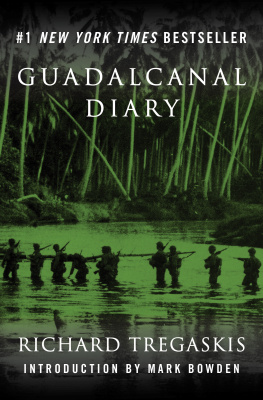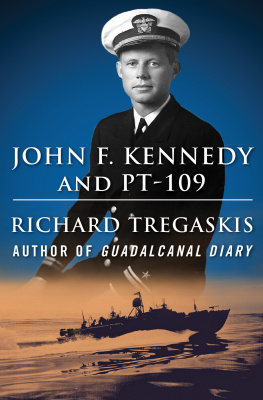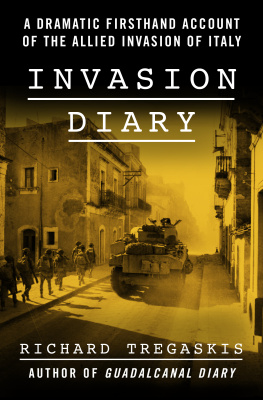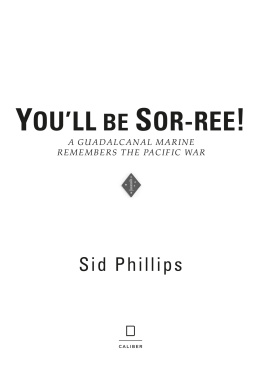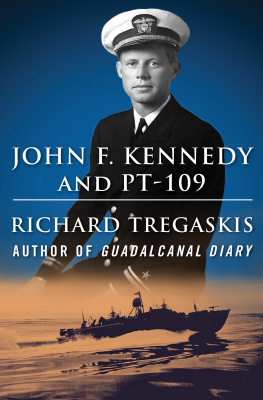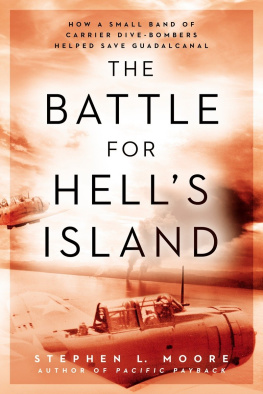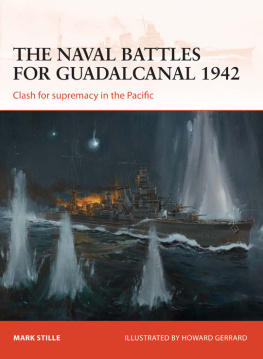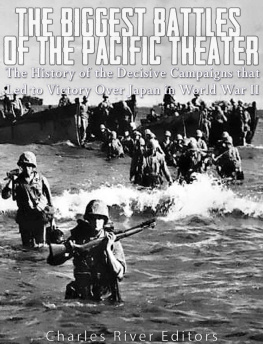Guadalcanal Diary
Richard Tregaskis

C ONTENTS
I NTRODUCTION
by Mark Bowden
War makes for great stories. It by definition involves matters of historical importance, and it is rivaled by few events in life for drama. It sounds mercenary for a writer to say so, but it has always been true. Stories about battle have been popular and significant since before language was written. Even poor accounts of itself-serving memoirs, bald propagandaoften make for compelling reading, because the deeds of war, the cruelty and self-sacrifice, the cowardice and heroism, are enacted at such extremes of human experience that they ultimately transcend the words that describe them. The very best stories of war tend to come from writers who understand this, who know their place, who recognize that the struggle they observe and record carries a great deal more weight than their account of it ever will. Abraham Lincoln touched on this when he spoke at Gettysburg, The world will little note, nor long remember what we say here, but it can never forget what they did here. We have long remembered, of course, what Lincoln said, but even his immortal words carry less weight than the deeds of the men who fought and died. The great thing about words, however, is that they enable memory.
Remembrance is the least we owe those who accomplished heroic deeds. Their stories are needed not only to inspire warriors who will be called upon to fight in the future, but to inspire us all with the best kind of national pride. In the words of the dying captain at the end of Saving Private Ryan, we are called upon to earn this.
During World War II, America fought a famous series of vicious battles against the Japanese on islands in the Pacific. Richard Tregaskis went along as a war correspondent for the first of those battles, on the island of Guadalcanal, and wrote an accounthis bestselling Guadalcanal Diarythat stands today as one of the best of its genre. Downplaying his own extraordinary heroism, writing with great fairness and restraint, Tregaskis shaped Americas understanding of the war, and influenced every account that came after, fiction or nonfiction, from Norman Mailers The Naked and the Dead to the 1998 film version of James Jones The Thin Red Line. Tregaskis described for the first time the look and feel and smell of the Pacific War, the oppressive tropical heat and humidity that caused rashes and strange fungi to appear on mens bodies, the terror of fighting in tall grass and in jungles against an often invisible enemy that burrowed deep in the earth and vowed a fight to the death, the odd transformation of paradisiacal Pacific landscapes into hell itself. Tregaskis brought to life the horror of that fighting, but also the inspiring camaraderie of men at war, the humorous details of life in a combat zone, the peculiar juxtaposition of the macabre and the mundane. He demystified this strange new ground war. His account revealed the hardened, professional Japanese suicide warriors of legend to be merely human, cunning, determined fightersmen vulnerable to American artillery and infantry. Above all, Tregaskis captured the stoic young Americans who calmly boarded landing crafts, knowing that probably one in four of them would be killed. His diary captured the inspiring determination and courage of typical young Americans in 1943, a motley racial and ethnic mix, who would prove to be more than a match for the fierce Japanese.
It is hard to imagine today how important this book was when it appeared in that year, just months after the fighting it describes. The fighting in Guadalcanal was the beginning of the land offensive against Japan. Today we know all about the island-hopping strategy that, together with even more important air and sea battles, gradually stripped away Japans control of the Pacific Ocean and crushed its empire. Then, nothing was certain. The U.S. Navy had won a decisive battle in June in waters off Midway Island, but sea battles merely set the stage for the grim series of island invasions. As of August of that year, Americans had known only defeat on land against the Japanesethe ignominious flight of General Douglas MacArthur from the Philippines, the humiliating surrenders of Bataan and Corregidor. This book recorded a turning point. America was striking back.
But the diary records much more than a first American land victory. When it was published, no one yet knew what this new war was going to be like. The Allies had not yet landed on Normandy to begin the big push against Hitler, and although American soldiers had seen plenty of action already in Africa, and just weeks before had invaded Sicily, there was something especially daunting about invading a small island in a vast ocean, where neither side could readily abandon the field. What sort of enemy were these Japanese? What kind of weapons and strategies would they employ? Why were these dangerous islands with strange names halfway around the world suddenly so important? What had we gotten into?
From a purely military standpoint, the most important battle of Guadalcanal was not the one fought on land and described so vividly in this book. It was fought at sea, miles away from the island, in November, months after Richard Tregaskis diary ends, when a decisive naval victory prevented the Japanese from landing reinforcements. The United States lost two cruisers and seven destroyers in that fight; the Japanese lost two battleships, one cruiser, two destroyers and, most important, ten troop transports. Preventing the arrival of those troops enabled the army and the stubborn, courageous Marines to finish mopping up Guadalcanal, securing their precious Henderson airfield, the first firm foothold on the long and bloody climb north toward Japan.
Any doubts about how young Marines would fare in this new war were erased by their swift victory and stubborn defenses. Tregaskis rode in on one of the first landing crafts, sharing the profound chill of foreboding as the invading force approached the beaches, and the enormous relief when it was discovered that the Japanese had been taken completely by surprise. With the islands defenders fleeing into the jungle, the landing itself was happily anticlimactic, but in the weeks that followed the fighting grew fierce. Tregaskis records the progress with calm daily entries in his diary, allowing the reader to experience the progress of the campaign just as the Marines did. There were so many acts of heroism, sacrifice, and survival to note that Tregaskis took to just listing them, encapsulating stories so remarkable that any one of them might have made a whole chapter. Theres Lieutenant Richard R. Amerine (of Lawrence, Kansas),
a Marine flyer, [who] came wandering into our lines today, thin as a ghost, to say he had been out in the jungles, dodging Japs and existing on red ants and snails for seven days. Having once studied entomology, the science of bugs, he was able to subsist on selected ants and snails. He knew which ones were edible.
Or two young corpsmen, Pharmacists Mate Alfred W. Cleveland (of South Dartmouth, Massachusetts) and Pharmacists Mate Second Class Karl B. Coleman (of McAndrews, Kentucky):
They told me how they had used a penknife to amputate the ragged stump of one Raiders arm after it had been shattered by a 75 explosion the medicos themselves had said that the man would have died if the two lads had not done such a good and quick job in the field.
Or Lieutenant (JG) Paul F. Kalat (of Worchester, Massachusetts),

